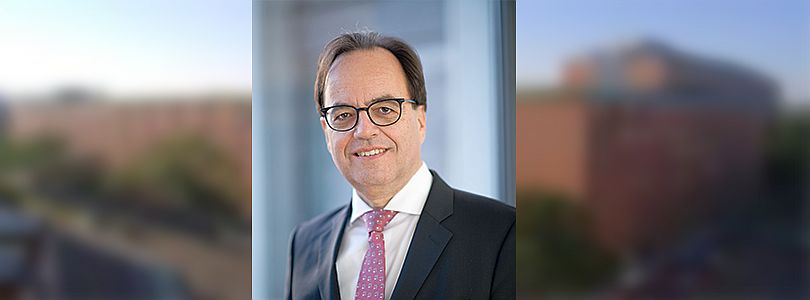Content
Hubert Rothe


„There was great optimism – even if not all of us were convinced of ‘blossoming landscapes’. The merger of the two offices was a great success but, in some cases, also left wounds that took long to heal.“
Head of Directorate General “Information” at the DPMA
DPMA:How did you experience the time of reunification in 1989/90 at the DPA?
Hubert Rothe:It was a very exciting time for me, both personally and at work. There was great optimism – even if not all of us were convinced of the promised “blossoming landscapes”. The integration of the patent office of the GDR – as the Office for Inventions and Patents (AfEP) was called several months before 3 October 1990 – into the German Patent Office, initially at the Berlin sub-office in Kreuzberg, was largely unproblematic. It was a huge effort of all those involved. But there were some problems: In individual cases, the transfer of the staff did not take place as hoped. This caused wounds people felt for a long time.
DPMA:When did you learn for the first time that the offices would be merged?
Hubert Rothe:I cannot recall that day. It was clear to all of us that the merger would take place after the GDR became part of the Federal Republic of Germany.
DPMA:Were there considerations as to a relocation of the patent office back to Berlin?
Hubert Rothe:Actually, this was not an issue for me – probably because nobody was able to imagine the Munich staff would have to move. It would also have been more difficult for the law firms, which also represent their clients before the European Patent Office, especially in view of the hearings and opposition proceedings.
DPMA:How was the collaboration between the colleagues from East Germany and West Germany?
Hubert Rothe:In our division, immediately after October 3rd, we had established contact with the AfEP at the working level. At the management level, there was a lively exchange even before that. I recall that both sides made efforts to approach each other without reservation and to cooperate closely. The Mohrenstraße staff, as we called them at that time because the East German office was located there, came to our Berlin sub-office for discussions almost every day and vice versa – and often also to Munich. These discussions were friendly and constructive. One evening, my wife and I received two women as guests at home.
DPMA:Did the colleagues from the library have to move to Munich?
Hubert Rothe:No. We were able to continue the employment of the colleagues who joined our division and my area of responsibility in Berlin. It was mainly the examiners that had to move to Munich. Immediately after reunification, we were able to recruit qualified applicants from the new Länder for Munich. Some of them still work with us.
DPMA:Thirty years later, how do you assess this unbelievably quick unification process of the two offices?
Hubert Rothe:: I believe it was a success. The positive aspects clearly prevail. After October 3rd, our Berlin sub-office on Gitschiner Straße was the branch office that received the staff of the patent office of the GDR. In the following years, there were many changes to existing tasks, the traditional case file processing was gradually transferred to Munich, new tasks were added, the organisational structure of the sub-office was repeatedly changed in the following years. This gradually led to a big reduction of staff, mainly because the examiners moved to Munich. As a consequence, in the late 90s, there was great insecurity among the Berlin staff about whether the office would have a future and what it would be like – this was understandable for us. I am glad that we managed to organise the office, now the IDZ Berlin, in such a way to permanently assign it with new tasks. Probably, this insecurity has largely vanished – at least, I hope so.
DPMA:What comes to your mind when you recall that time?
Hubert Rothe:I gladly remember my three or four official trips to Berlin at the very beginning of the 90s. We then always used the official car to go from Gitschiner Straße to Mohrenstraße by using a short rat run through a wall breakthrough in a side street. The ride took only a few minutes. What was also great was the possibility to have lunch in the canteen of the Academy of Sciences of the GDR (AdW) on the other side of the street. The AdW had not yet been wound off at that time. At the beginning, there was a sense of optimism in many areas of the two offices – albeit not everywhere.
Fortunately, the office on Gitschiner Straße had free space, for the structure of some areas of the office on Mohrenstraße was in less good condition. A few colleagues from the library in the Mohrenstraße office moved to Gitschiner Straße. Later, the entire building was vacated and renovated. When I now visit the Federal Ministry of Justice and Consumer Protection, I recall my visits to Mohrenstraße, as the Federal Ministry of Justice and Consumer Protection is located in the renovated former building of the AfEP.
Last updated: 10 December 2025

Not only protecting innovations
Social Media